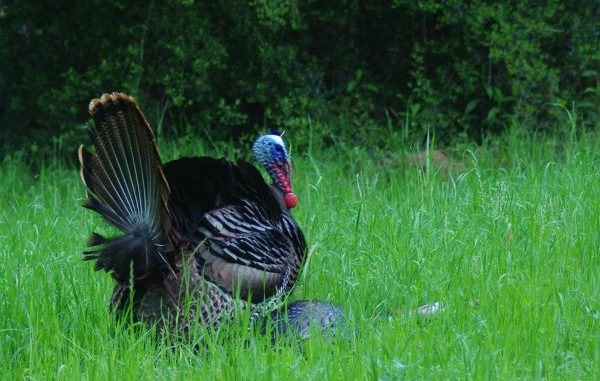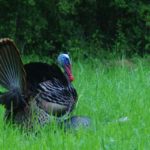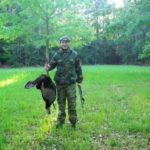
Season starts off with two toms down
The late Ken Morgan believed that turkey hunting was a one-man game. In fact, he wrote a book titled “Turkey Hunting: A One Man Game.” In the preface of the book, he states that the solitary hunter alone in the woods gets the maximum amount of relaxation and pleasure from the game.
It is often said that if a turkey could smell like a deer a hunter would always come home empty-handed. With their excellent hearing and vision, the wild turkey is indeed an awesome challenge. But as with all of our hunting activities, it is not about the killing; it is about the pursuit, but it sure is good when you win sometimes.
An email from Jimmy Stafford, the state turkey biologist for LDWF, indicated that the early spring boded well for turkey hunters, especially for the youth hunts. Past weather conditions for the youth hunts has not been very conducive for turkey hunting, but this year the conditions were excellent and the young hunters heard lots of good gobbling, and many were successful in connecting with a tom. His turkey-killing son David James Stafford, who is a freshman at Louisiana Tech, had been having success with Mississippi gobblers, so it sounds like it is going to be a very good year in the Southeast for turkey hunters.
Prior to the regular-season opening day, I made my usual scouting trip with my camera. The only calling I did was to make a few tree yelps to see if a tom was nearby, and I was pleased to hear several gobblers that morning. In fact, I had a gobbling and strutting bird at 20 feet but, alas, the fog would not lift and the photo shoot for the day was a wash-out.
I could only hunt a few hours opening day before heading out to Alexandria to conduct a deer-hunting workshop (such activities should never happen when the turkey season is open; you people who coordinate programs should keep this in mind).
So after the tom left the patch with the hen I began formulating the strategy for opening morning.
A great hunt
My son Ruffin and I were in the turkey patch well before daylight, getting things ready for the game to begin. We had a good hunt last year but, unfortunately, the Ruff man missed, so he was ready to redeem himself.
I set a hen decoy in the patch on the woods trail that we walk in on so the tom I played with Friday would see it when it came around the curve and down the ridge on the trail toward the patch.
We placed another hen decoy and a jake decoy out in front of the turkey box, just in case other gobblers from the north came our way and the Friday gobbler didn’t want to play.
There were several toms gobbling at daylight, but the Friday tom appeared to be silent. I did a little tree yelping to let them know we were in the area, and we sat back and listened to the gobbler talk.
I finally started calling with the other calls, and it appeared that two toms were on the ridge about 100 yards to the north of us. I felt pretty certain one was getting close, and in a few minutes I told Ruffin to look at the northwest corner of the patch. A tom was standing there with bright-red caruncles (the fleshy wattles).
I took the Knight & Hale slate and peg, and made a few soft calls; the tom gobbled and strutted. I did it again, and again the tom responded with a gobble and strut, and then started moving our way.
I thought the bird was heading for the hen, but then it apparently saw the jake and hen decoy and picked up the pace.
It appeared the gobbler was skimming the surface of the grass as it hastily made its charge. The tom slowed as it approached the jake decoy, and then in full strut circled it and then attacked with several blows from its legs.
The decoy fell over, and the victorious tom — in full strut — stood on it.
I had been taking pictures of the activity and was hoping the camera wasn’t shaking too much from my excitement.
I told Ruffin that whenever he was ready he probably should take the shot, and in a few seconds he fired his Mossberg.
In the off season he had converted the shotgun into a tactical-looking firearm with pistol grip and new sights, and had tried out several loads with his different choke tubes.
I don’t think I have seen a bird not do any flopping after being hit; this tom just fell over and remained motionless.
We shared a father/son moment, and then he proceeded to tag it while I picked up the decoys.
The gobbler weighed 18 pounds, had a 9-inch beard and ¾-inch spurs — a fine East Feliciana Tom.
There were gobblers still talking in the woods, but it was time for me to head to Alexandria.
A really great hunt
I returned to the turkey games Monday morning, and for the next several days heard a good bit of gobbling. On several occasions I thought it was going to happen, but the defense of the toms was too good and my strategy wasn’t working.
On the following Saturday, I had a tom in the patch coming to me, but at 50 yards it stopped, eased into the woods and disappeared. This was the first time I had not put out a decoy, and that may have been the problem; the tom was hearing a hen, but there was no hen in sight.
Driving home, I began planning a strategy for the next week, and finally decided I would try the turkeys at Camp David on Monday. I had checked the turkey-patch camera one day around noon after a morning hunt on the other tract and had brought my calls and gun with me.
I had put up a blind at this patch in February. There were no turkeys on the photo card, only the midnight hog passing through.
I yelped real loud with the box call, and was surprised when a tom gobbled back off in the distance. I sat in the blind for about 30 minutes, but never heard the tom again.
This gave me confidence that the gobblers we had seen during the winter were still around.
It is tough hunting turkeys on small tracts, mainly because of the property size and the fact that the birds cover a lot of ground. For the last few years, I have worked real hard to make the tracts attractive so that at some point during the day the turkeys visit the property.
One activity I like to do before the turkeys hatch out is to cut strips through the patches to give the little poults areas to search out insects. The adult turkeys also respond to this; the grasshoppers and the katydids will be in the tall grass, while the crickets and other critters will be hiding in the short grass and clippings.
I was at Camp David early Monday morning and waited until breaking light to ease back to the blind.
I set out a hen and jake decoy, and then did a little tree yelping. A tom finally gobbled off to the southeast, and then one gobbled straight across from me.
It was another one of those foggy mornings, and the gobbling didn’t last long. They seemed to respond to the raspy calling that I would do with the box, the mouth call, and the slate and peg. I finally decided they were on the ground, and so I reduced the frequency of calls.
At around 8:30, I could hear some hen talk close by and I started some soft talk with them, but their calling faded away. If the gobblers were with them, they weren’t talking to let anyone know they were.
Fifteen minutes later, I looked to my left down the narrow patch I was set up on and saw movement.
A hen and a gobbler came around a big pine about 50 yards away, and stopped and stared in my direction.
I did some soft calling, and the hen moved toward me. I thought maybe if she would just walk this way, even if she walked around to avoid the decoys, I could get a shot, but she turned and acted like she was going to walk away.
The gobbler had walked back behind the pine tree, but as she moved past him scratching and feeding it stepped out and looked in my direction.
I kept up the soft calling with my modified mouth call (a three diaphragm call that I had converted to two), and the slate and peg.
I had already had the old Revelation 12 gauge in position just in case.
The tom stood his ground at 50 yards, but finally I could see his colors begin to show. It made a soft gobble, and then strutted.
It walked around the pine tree and strutted some more; all the time I was softly clucking, purring and yelping.
It finally started moving in my direction, and at 35 yards I squeezed the trigger and the first Camp David turkey was on the ground.
After a short tagging and photo session, I headed back to the camp to hang it by the Camp David sign to document this historical event with one more photo.
With 20 more days left in the season, the 2012 Turkey Games have already been sensational.




